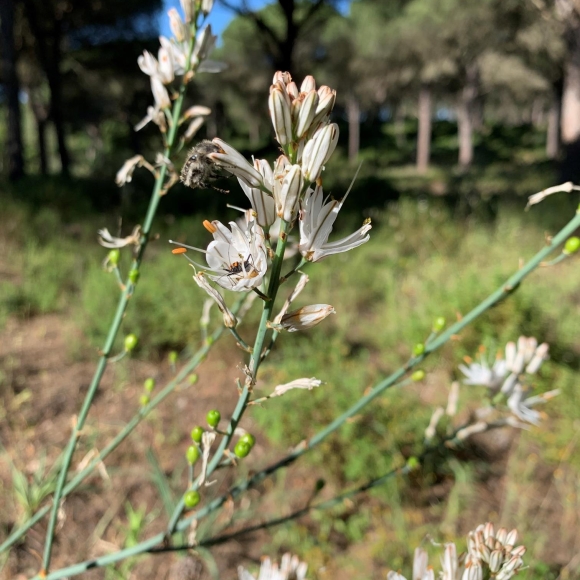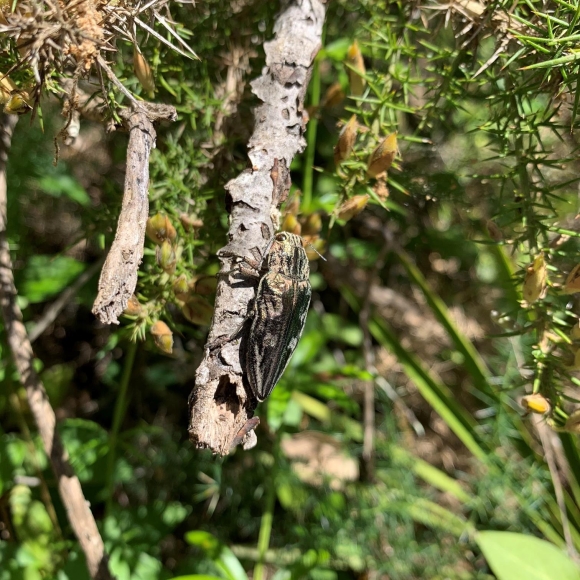
GONHS May Outing: Finca La Alcaidesa
The outing to Finca La Alcaidesa, on the 15th May, was the first GONHS outing to Spain since before the pandemic.
Perhaps because of this, it was well-attended by a group of 15 eager naturalists of diverse ages and interests. The Finca is owned by the Junta de Andalucia and consists mainly of mixed Stone Pine Pinus pinea and Cork Oak Quercus suber woodland. It is a beautiful area within a short drive of the Rock, adjoining the northern perimeter of the Pinar del Rey.
Some of the members of the group were keen birders. A group of Bee-eaters whilst driving into the Finca were the only Bee-eaters of the day. Golden Oriole was heard singing as soon as we parked. We eventually saw three birds, but only after very hard work. Turtle Dove was purring nearby. A few Honey Buzzards flew out from the valley in the early morning; they must have roosted there after crossing the Strait on their migration north. A Common Buzzard alighted on a tree ahead of us. Once we set off on our walk, woodland birds were ubiquitous. Robin and Chaffinch were common. Western Bonelli’s Warblers sang everywhere in the canopies. We only saw one Iberian Chiffchaff: they prefer moister habitats. Blue and Great Tits were supplemented with Crested Tits and a large party of Long-tailed Tits. A Short-toed Treecreeper with prey in its bill was on its way to its nest. Nuthatch was heard but proved difficult to locate. Wood Pigeon was frequent but unobtrusive. The drumming of Great-spotted Woodpeckers resonated throughout. In a more open area, we heard Woodlark and Common Cuckoo.
The botanists, lagging behind, were soon finding interesting species. The Violet Limodore Limodorum arbotivum, an orchid that parasitises fungi and lacks chlorophyll was common, but most had gone over and only one had flowers on it. A couple of Bee Orchids Ophrys apifera were also observed. We had better luck with another, quite incredible parasite: some of the Cytinus hypocistis had also finished flowering, but others still had some flowers. This small, very unusual plant is a parasite of a variety of Cistaceae, but here it was associated with Sage-leaved Rockrose Cistus salviifolius. It was the Rockroses that were providing a lot of the colour, with the deep pink Cistus crispus and yellow Halimium halimifolium, Halimium atriplicifolium and Spotted Rockrose Tuberaria guttata standing out. The dainty Coronilla juncea was very different to Gibraltar’s Coronilla valentina. Some plants open their flowers during periods of low light, whilst others need sunlight and warmth. Silene colorata were open in the morning, but it was only once the sun was beating down that we realised that areas of ground were covered in Campanula lusitanica.
Where there is a diverse flora, there is a diverse insect fauna. There were certainly many butterflies about. Showier species included the Cleopatra Gonepteryx cleopatra, Swallowtail Papilio machaon and Two-tailed Pasha Charaxes jasius, but by far the most common and conspicuous species was the Spanish Gatekeeper Pyronia bathseba, with many flying low over the forest floor. Huge Scarabaeus dung beetles flew around searching for the dung of large mammals. An incredible sight were the many male Mammoth Wasps Megascolia maculata flying back and forth over a small meadow, perhaps searching for females. This, the largest wasp in Europe, parasitises the Rhinoceros Beetle Oryctes nasicornis. Another spectacular insect was the Flat-head Pine-borer Chalcophora mariana, a large and beautiful jewel beetle that was intercepted whilst flying between pines. Finally, the always-pleasing Spoonwing Nemoptera bipennis offered good views.
Due to coronavirus, we decided to forfeit our usual tradition of having lunch in a restaurant and decided to take a packed lunch instead. We sat in the shade of Cork Oaks as we ate, talking about the cork industry and reflecting on the quality of the habitats and species observed. It had been a perfect return to our Spanish outings, which we hope to be able to continue.









